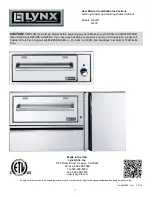
- 8 -
04/2019
Copyright © 2019, Fast ČR, a.s.
Tomatoes
Rinse and remove stems. Soak in
boiling water until peels soften.
Cut in half or cut into slices.
Hard
8-24 hours
Rhubarb
Peel, dip in lemon solution
Hard
8-38 hours
Beetroot
Cut away the roots and everything
that is 2.5 cm from the top and
bottom part, wash, precook, cool
and remove the peel. Cut into
cubes or slices.
Crunchy
8-26 hours
Celery
Separate stem from leaf. Wash both
parts carefully. Cut the stem into
slices approx. 0.6 cm thick. First
dehydrate the leaves.
Crunchy
6-14 hours
Spring
onions
Cut into halves or into small pieces.
Brittle
6-10 hours
Asparagus
Rinse and cut into 2.5 cm pieces.
The tips provide better quality
product. The rear part when
crushed before dehydration makes
an outstanding flavouring for
various meals.
Crunchy
6-14 hours
Garlic
Separate into individual cloves,
remove outer peel, cut into slices
and dehydrate on trays.
Very brittle
6-16 hours
Spinach and
other leafy
vegetables
Wash thoroughly, remove tough
stems.
Steam until the vegetables are
limp, though not saturated.
Very brittle
6-16 hours
Herbs,
spices and
flowers
Cut into pieces or chop into small
pieces. For decorative purposes,
leave whole.
Brittle
8-10 hours
TURNING OFF THE FOOD DEHYDRATOR
■
When you have finished dehydrating, open the door.
■
Set the main switch
A1
to the OFF position. Unplug the power cord of the food
dehydrator from the power socket. If you wish to move the food dehydrator to
another location, first allow it to cool down completely.
STORING DEHYDRATED FOOD
■
Before wrapping or storing dehydrated food, allow it to cool down first. Only use
suitable packaging for storage, for example glass canning jars, air-tight containers,
food-grade plastic bags or packaging, that are resistant against ingression of
moisture. Do not use plastic or aluminium containers. Metal cans with flip open lids
may be used only if the dehydrated food is placed in plastic bags.
■
Store dehydrated meat at room temperature in a closed container in a dry, dark
location. Stored in this way it will remain tasty and edible for several weeks or even
months.
■
Package dehydrated food in smaller amounts as tightly together as possible, but do
not push it against itself.
■
Do not store herbs and spices in paper bags because the oils contained in them will
be absorbed by the paper, which will ruin them. The best type of storage container
is again a glass jar with a firm locking mechanism, and in the case of flowers glass
jars with a wide neck for easy handling.
■
Place dried flowers, leaves and blossom petals into glass jars with a wide neck. When
necessary, add 3-4 drops of an aromatic oil to rejuvenate the fragrance and close
the container. Shake the contents and store them in a cool place. In this way, the
aromatic contents will always be available.
■
Ideally, store the containers in a dry, dark place at room temperature or lower. At
temperatures below 10 °C, their shelf life is extended by 2–3 times. Dried fruits have
a shelf life of at least 1-2 years.
■
Consume the entire contents after opening, ideally all at once. Inspect the stored
dehydrated food at least once per month.
■
Inspect dehydrated food regularly once per month. If you find mould on the
surface of the food, separate it from the remainder and dispose of it. Pasteurise
the remaining pieces that were not attacked by mould. To pasteurise the contents,
arrange the food on a cake baking tray and bake in an oven for approximately 15
minutes at a temperature of 80 °C. Then allow the food to cool down and repack
into a clean airtight package.
REHYDRATION
■
Rehydration serves to reconstitute food to its initial state. However, not all
dehydrated food must be reconstituted. Especially fruit is better in the dehydrated
state. On the other hand, most types of vegetables are tastier when reconstituted
to their initial state.
■
Through rehydration, food is returned practically to its initial size, shape and
appearance. If handled correctly, it retains most of its aroma and taste, as well as
minerals and a significant amount of vitamins.
■
To reconstitute vegetables for cooking, simply wash them in clean water and then
place them in cold, unsalted water and cover. If possible, allow them to soak for
approximately 2–8 hours, then cook them in the water that you used for soaking. If
necessary, add more water. Bring to a boil, then reduce the temperature and gently
cook until ready. At the end of the cooking process, you may also add salt, which
will slow down the reconstitution process. As far as fresh products are concerned,
overcooking them will reduce their aroma. To reconstitute vegetables, e.g. carrot,
use cold water for soaking. Dehydrated food may be reconstituted by soaking,
cooking or a combinations of both these methods and after reconstitution will look
similar to the fresh state.
Attention:
Dehydration does not rid food of bacteria, yeasts and
moulds. If you extend the soaking process at room
temperature, this will risk spoilage. Therefore, when soaking
fruit or vegetables for longer than 1–2 hours, place the
container into a refrigerator.
■
To prevent food from losing its nutritional value, use the water from the soaking
solution when preparing various recipes. The volume of one cup of dried vegetables
is equivalent to approx. 2 cups after reconstitution. To replace the moisture that was
removed during dehydration, pour cold water over the vegetables and soak them
from 20 minutes to 2 hours. Then pour boiling water over the vegetables. When
cooking, bring the vegetables to a boil and then leave them to simmer.
■
The volume of one cup of dried fruit is equivalent to approx. 1 1/2 cups after
reconstitution. Add just enough water to cover the fruit – its possible to add more
water later if necessary. 1–8 hours is sufficient for reconstituting the majority of
fruits. It depends on the type of fruit, size of pieces and water temperature (the
process is shorter in hot water). If the soaking time is too long, the fruit will lose
aroma. To cook reconstituted fruit, cover the container and simmer it in the water
in which you soaked it.
■
Dehydrated or reconstituted fruit and vegetables may be used in various ways.
■
Dehydrated fruit is suitable for preparing refreshments both at home and on trips.
Fruit pieces can be added to bread products or confectionery.
■
Reconstituted fruits can be served as compotes or sauces. They may also be used as
ingredients in recipes for making bread, jelly salads, omelettes, gugelhupf, stuffing,
milkshakes, ice creams and cooked cereals.
■
Dehydrated vegetables can be used in soups, stewed meat dishes, made into
vegetables platers, or used as dry refreshments.
■
Reconstituted vegetables can be use in your favourite recipes like meat cakes and
other main dishes, in jellies or vegetable salads.
■
Crushed dehydrated vegetables are an excellent ingredient for meat bouillon, soups
and sauces.
■
For optimal retention of nutritional values, we recommend:
- adhere to the correct pre-cooking time.
- package dehydrated food correctly and store in containers in a cool, dry and dark
place.
- regularly inspect stored foods, checking for absorption of moisture.
- consume dehydrated foods as soon as possible.
- when cooking reconstituted food, use the soaking solution.
TROUBLESHOOTING TABLE
PROBLEM
POSSIBLE CAUSE
SOLUTION
The food
dehydrator
cannot be turned
on
■
Power cord is not
connected to the electrical
power grid.
■
Set the main switch to
position ON.
■
Connect the food
dehydrator to the power
grid.
■
Set the main switch to the
ON position.
The fan turns but
the dehydrator
does not
generate heat.
■
Malfunction of dehydrator.
■
Turn off the dehydrator,
disconnect it from the
mains and contact an
authorised service centre.
The fan is making
an unusual noise.
■
The grille cover of the fan
is hitting the fan blades.
■
Turn off the dehydrator,
unplug it from the mains
and gently pull the grille
cover away from the fan
blades. If this does not
resolve the noise issue,
contact an authorised
service centre.
The dehydrator
generates heat
but the fan is not
spinning.
■
Check whether a foreign
object, dirt or pieces of
food are preventing the
fan blade from turning.
■
Clean the fan.
■
If it does not turn even
being cleaned, contact an
authorised service centre.
Food is not well
dehydrated
■
Too much food was placed
on the trays.
■
Food pieces are too
close together or are
overlapping each other.
■
Reduce the amount
of food.
■
Rearrange the food on
the trays.
Water drops
or humidity is
forming on the
door.
■
Too much food was placed
on the trays.
■
The food contains too
much moisture.
■
Reduce the amount
of food.
■
Increase the dehydration
time.
The dehydrator
is overheating or
alternatively not
producing heat.
■
The temperature control
system is not working
correctly.
■
Turn off the dehydrator,
disconnect it from the
mains and contact an
authorised service centre.



























